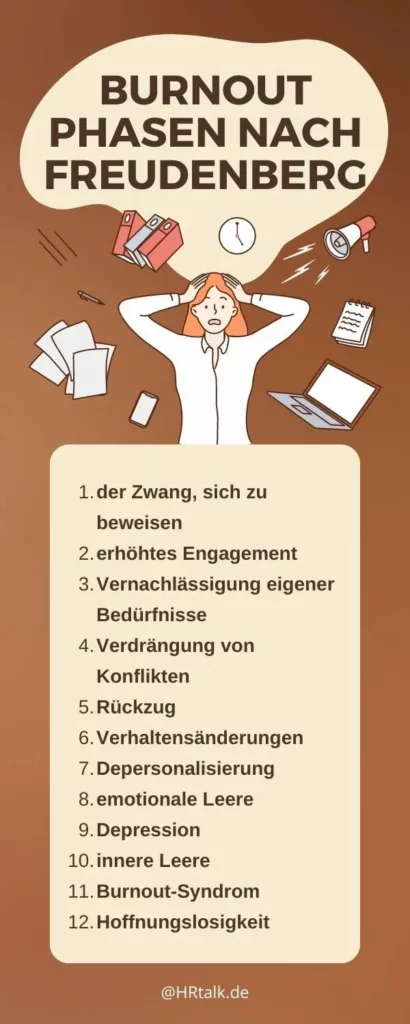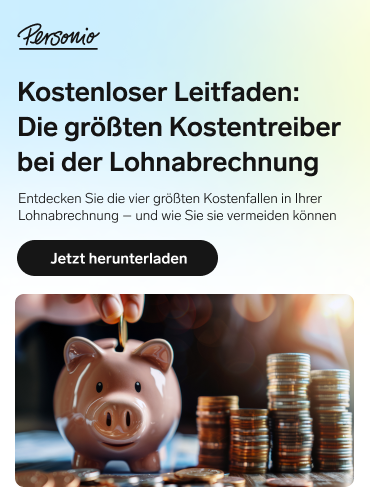Burnout phases 2025 | The feeling of mental exhaustion can be overwhelming. We often wonder whether it is a serious mental illness. The diagnosis can be a relief, as it paves the way to proven treatment options and provides insight into the course of our symptoms. The course of a burnout is often described in different phases, which can help us to understand the overall picture. In this article, we will take a closer look at the various burnout phase models and draw valuable insights from them.
Burnout phases according to Freudenberger
The psychoanalyst Herbert J. Freudenberger introduced the term burnout into the specialist literature in 1974 and described 12 phases of burnout. These burnout phases do not have to occur in the specified order and can vary in intensity. The Freudenberger burnout phases provide an overview of the progression of the burnout syndrome:
- the compulsion to prove yourself
- Increased commitment
- Neglect of own needs
- Repression of conflicts
- Withdrawal
- Behavioral changes
- Depersonalization
- emotional emptiness
- Depression
- inner emptiness
- Burnout syndrome
- Hopelessness
These phases can extend over a longer period of time and are not always linear. It is important to recognize the signs of burnout at an early stage and take appropriate measures to prevent the symptoms from worsening.

Burnout phases explained according to Freudenberger
The Freudenberger burnout phases provide a detailed insight into the progression of the burnout syndrome and are divided into a total of 12 stages. These phases illustrate the gradual development of the syndrome. A brief overview of the phases is given below:
Phase 1: The compulsion to prove yourself – In this first phase, you feel a strong urge to constantly prove yourself and be perfect, whether professionally or personally.
Phase 2: Increased commitment – In the second phase, people increase their commitment and work hard to achieve their goals, often at the expense of their own needs and well-being.
Phase 3: Neglecting your own needs – In this phase, your own needs increasingly take a back seat as work comes first.
Phase 4: Conflict repression – Conflicts are avoided and repressed instead, which can lead to a further increase in internal pressure.
Phase 5: Withdrawal – In this phase you withdraw and avoid social contact in order to protect yourself from further stress.
Phase 6: Behavioral changes – Behavioral changes such as aggressiveness or irritability occur, which can be noticeable in both the professional and private environment.
Phase 7: Depersonalization – Work becomes increasingly impersonal and you distance yourself from colleagues and customers, which leads to further alienation.
Phase 8: Emotional emptiness – In this phase you feel empty and burnt out, your emotional resources are exhausted.
Phase 9: Depression – Depressive symptoms such as depressed mood, listlessness and hopelessness may occur.
Phase 10: Inner emptiness – Inner emptiness and exhaustion continue to increase in this phase.
Phase 11: Burnout syndrome – In this phase, the burnout syndrome reaches its peak.
Phase 11: Burnout syndrome – In this phase, the burnout syndrome has reached its peak and is fully developed, making it almost impossible to cope with the stress.
Phase 12: Hopelessness – In this final phase, the affected person feels hopeless and sees no way out.
These phases provide a framework for better understanding the development of burnout syndrome and can help to intervene at an early stage to prevent the syndrome from fully developing.
What should I do if I recognize one of the burnout phases?
If you recognize one of the phases of burnout syndrome in yourself, there are a few things you can do to deal with it:
Take some time out: it’s important to take time to relax and recharge your batteries. This could be a vacation, a mental health day or simply a break during the working day to go for a walk or practice mindfulness exercises.
Seek support: Talk to a trusted friend, family member or professional therapist about what you are going through. They can support you emotionally and help you to develop coping strategies.
Practice self-care: Engage in activities that promote your physical and mental well-being, e.g. exercise, healthy eating and sufficient sleep.
Set boundaries: Draw clear boundaries between work and private life and prioritize activities outside of work that bring you joy and fulfillment.
Seek professional help: If your symptoms persist or worsen, you should consider seeking professional help from a therapist or psychologist.
What are the advantages of the Freudenberger burnout phase model?
The burnout phase model developed by Herbert J. Freudenberger provides a valuable framework for better understanding the burnout syndrome and its progression. By describing the various stages of burnout, the model enables individuals and organizations to look out for warning signs at an early stage and take appropriate action. In addition to this comprehensive understanding, the burnout phase model offers further advantages, which are explained below.
Comprehensive understanding: recognizing the different stages of burnout
The burnout phase model developed by Freudenberger offers a comprehensive understanding of the various stages of burnout. If you familiarize yourself with this model, you can recognize the first signs and develop an awareness of your own situation. By understanding the specific phases, targeted measures can be taken to prevent the burnout from worsening.
Focus on self-care: the importance of boundaries and self-care
A central aspect of the burnout phase model is the emphasis on self-care and setting boundaries. The model illustrates how important it is to look after yourself and not neglect your own needs. Through active self-care and setting healthy boundaries, people can deal better with stress and prevent burnout.
Intervene at an early stage: Recognizing the long-term development of burnout
The burnout phase model recognizes that burnout is a gradual process that can take months or even years. It emphasizes the importance of early intervention and prevention. By understanding the stages of the model, individuals can act early and take action to prevent their situation from deteriorating further. This enables timely support and help in overcoming burnout.
Screening instrument: Identification
The burnout phase model can also be used as a screening tool to identify people who are potentially at risk of burnout. Organizations can use this model to carry out targeted interventions and offer support. By recognizing people at risk, preventative measures can be taken to support the individual and reduce the risk of complete burnout.
What burnout phase models are there?
The course of burnout syndrome is often described using various phase models, which help to better understand the development and symptoms of this severe psychological stress. In addition to the well-known burnout phases according to Freudenberger, there are other models that provide valuable insights.
Here are some of the best-known models:
- The 12-stage model according to Freudenberger and North: This model describes the progression of burnout syndrome in 12 stages, starting with the compulsion to prove oneself and ending with hopelessness.
- The 6-phase model according to Kaluza: This model describes the progression of burnout syndrome in 6 stages, starting with excessive demands and ending with resignation.
- The 4-phase model according to Pines and Aronson: This model describes the progression of burnout syndrome in 4 stages, starting with enthusiasm and ending with resignation.
- The transactional model: This model describes the progression of burnout syndrome as a result of imbalances between work demands and individual resources. It consists of three stages: Work stressors, individual stress and burnout.
There are also other models and approaches that shed light on specific aspects of burnout syndrome. Some models focus on personal resources and coping strategies, while others emphasize the influence of organizational factors and working conditions.
The variety of burnout phase models makes it clear that the syndrome is a complex interplay of different factors. Each model offers a specific perspective and can help us to better understand the individual experience of burnout.
By examining the various burnout phase models, we expand our understanding of the dynamics of the syndrome and lay the foundation for targeted prevention, early detection and treatment.
It is important to note that everyone reacts differently to stress and strain and that burnout is an individual experience. The phase models serve as orientation and help to recognize patterns, but are not to be understood as rigid guidelines.
Can employers recognize the burnout phases?
Employers can recognize the phases of burnout syndrome in their employees and react accordingly. There are a variety of signs and symptoms that can indicate that an employee is suffering from burnout. This includes
- Mood swings,
- Sadness,
- Concentration problems,
- Disinterest,
- emotional exhaustion,
- Tiredness,
- lack of motivation,
- high stress level,
- Anxiety,
- Irritability,
- reduced productivity,
- Drop in performance,
- increased absenteeism and
- Unpunctuality.
Employers should also look out for changes in behavior, such as increasing isolation or reduced communication with colleagues. It is important to recognize these signs and take appropriate measures to respond to employees.
Employers can take various measures to deal with phases of burnout. This includes providing support and resources for employees, e.g. counseling or psychological support. They can also introduce measures and practices that promote work-life balance and reduce stress.
Open communication and the creation of a corporate culture that promotes the well-being and mental health of employees are also of great importance. By raising awareness of burnout phases and offering appropriate support, employers can help to improve the well-being of their employees and prevent the development of burnout.
Recognizing and overcoming burnout phases is a joint responsibility of employers and employees. By taking a proactive approach, employers can help create a healthy and supportive work environment where employees can perform at their best.
How can Freudenberg’s burnout phase model be used in HR?
Freudenberger’s burnout phase model can be used in human resources (HR) to prevent and manage burnout among employees. The model offers HR professionals various possible applications, which are explained below. The model can be used to implement targeted interventions, intervene at an early stage and promote a healthy working culture.
Screening tool for the early detection of burnout phases
The 12-phase burnout screening tool based on Freudenberger’s model can be used as an instrument for the early detection of burnout. HR experts can use it to identify potentially at-risk employees and implement targeted interventions and support options. This makes it possible to cope with stress and prevent burnout.
Training and educational measures for burnout phases
The model can be used by HR professionals to inform employees and managers about the different phases of burnout and the importance of self-care and stress management. Training and educational measures create a culture of well-being and prevent burnout from the outset.
Early intervention of burnout phases
By recognizing the early signs of burnout, HR professionals can intervene early and offer support to affected employees before burnout worsens. This can include flexible working arrangements, access to psychological resources and the promotion of breaks and self-care.
Development of guidelines for the prevention of burnout phases
The model can be used by HR professionals to develop policies and procedures that promote employee wellbeing and prevent burnout. This includes, for example, guidelines on workload distribution, work-life balance and supporting employees through appropriate programs.
Closing words
The course of a burnout syndrome is complex and individual. The various burnout phase models give us valuable insights into the development and symptoms of this severe psychological stress. Understanding the phases makes it possible to recognize warning signs at an early stage, take preventive measures and offer adequate support.
It is important to emphasize that burnout is not a fate that we are helplessly at the mercy of. With timely attention, self-care and professional support, we can influence the course of burnout syndrome and set ourselves on the road to recovery.
In addition to knowing the phases, it is important to develop individual coping strategies and maintain a balanced lifestyle. Paying attention to your own needs, setting boundaries, building social support and regularly balancing work demands with relaxation are key aspects of burnout prevention and management.
In this article, we have provided a comprehensive overview of the burnout phases, presented various phase models and gained insights into the dynamics of the syndrome. Now it is up to us to apply this knowledge and be mindful of our mental health.
Marketing books that develop you professionally and personally
They exist, the best marketing books in the world. If you want to learn from the best of the best, I have just the books. They inspired me from the ground up, let’s see what great ideas will come to you as you read the books.










0 Comments